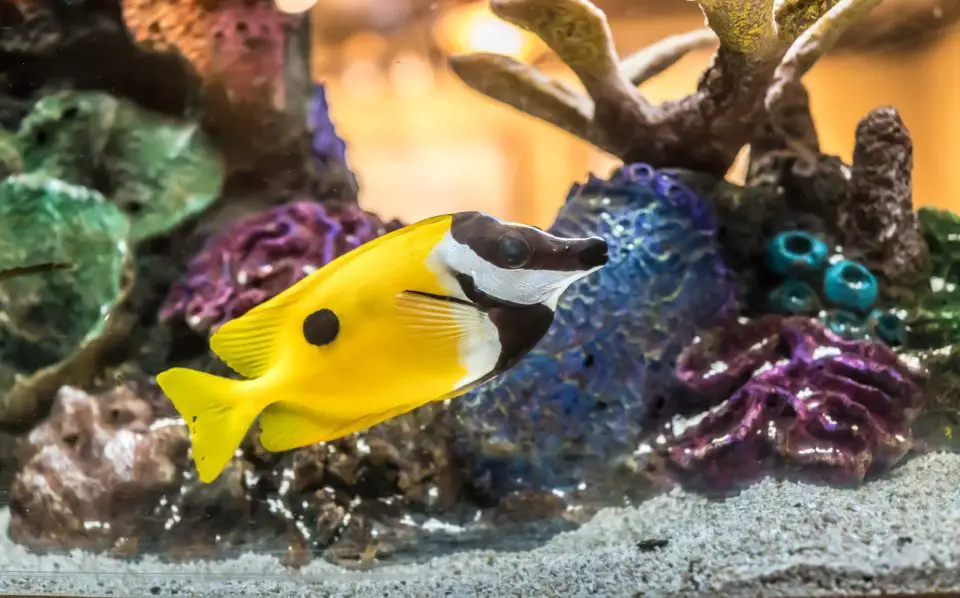What Are Tropical Fish?
Tropical fish are freshwater and saltwater species usually from the beautiful aquatic tropical areas of the ocean.
Typically fish have the entire ocean to make their home, so putting them in a microcosm of their environment means being aware of a lot of factors to prevent their death.
This article is going to be covering the compatibility of the fish in your tank, and why it’s important to have fish that get along with each other.
Relaxing and quiet, tropical fish are a great pet that will bring you joy for years! From small to large, passive to aggressive, it can be a big adventure introducing fish to each other.
It’s best to have each fish have a minimum of one gallon of water in personal space, as well as a variety of hiding spots like caves, fake and real seaweeds, and rocks.
Creating a balanced environment for your tropical fish will be the key to creating a relaxing environment for family members of all ages to explore.
From passive, to semi aggressive, to aggressive fish, it’s best to do your research on compatibility between fish. If you already have a fish, look for fish that have similar personality traits.
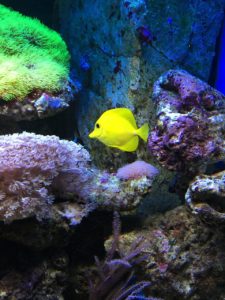 Passive fish get along with other passive fish. Fish of the same size will also work well together. Getting a larger fish creates a risk of it eating smaller fish.
Passive fish get along with other passive fish. Fish of the same size will also work well together. Getting a larger fish creates a risk of it eating smaller fish.
Sometimes fish of different breeds will become aggressive. Pay attention to the areas your current fish eat, and look for a fish that eats in a different area.
Does your current fish eat everything from the top? Look for a similarly sized bottom feeder! That will make each one feel like they are not having to defend their food.
Sex of fish is also very important. Some male species will fight any other male in the tank. And some male species will fight the opposite sex after they’ve mated.
Stress is the number one killer of tropical fish. Avoid the heartache of a cherished pet by paying attention to their nuances, and acting accordingly.
Sometimes fish not getting along can be inevitable. Each species of fish has very specific personalities, and it’s difficult to know what will affect them when in a new environment.
Pay attention to the factors below, and you will have success in having your tropical fish together for years to come.
Why’s it Important to Have Compatible Fish?
Having compatible fish prevent a lot of time, frustration, and money being wasted on your end. Compatibility avoids a possibly destructive situation within your tank environment.
Sometimes fish don’t get along but can live in the same area, while other might constantly fight for dominance. This can mean one fish gets maimed, or even eaten.
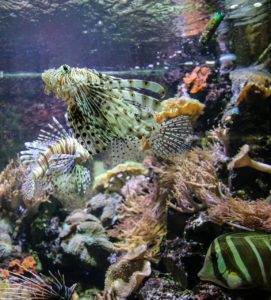 Constant fighting causes stress for all the fish in the environment, which can cause a lot of referred problems.
Constant fighting causes stress for all the fish in the environment, which can cause a lot of referred problems.
It’s best to avoid all of this by choosing fish that get along with each other. Or at least can cross each other without wanting to kill.
There are general rules to follow when having trying to put multiple fish in a tank. Peaceful fish can be with aggressive fish, but only if there’s enough room for them.
Varying personalities can get along if there are an appropriate amount of hiding spaces.
Plenty of fake and real plants, as well as caves, allow for smaller fish to have areas of respite from larger fish. This can prevent stress, thereby increasing the longevity of the lives of your fish!
What Tropical Fish Can be Kept Together?
Tropical fish can be a treat for the senses. They instill responsibility for the young child learning to care for a pet, while an adult handles the major cleaning.
Welcoming a new fish into your aquarium can be an exciting time. Use this handy guide below to see if the tropical fish can be kept together:
Guppies
Guppies are the perfect fish to have with others.
Peaceful and feed from above, it’s best to avoid larger fish in the same tank. Larger fish enjoy nipping on their flowing fins.
Corydoras Catfish
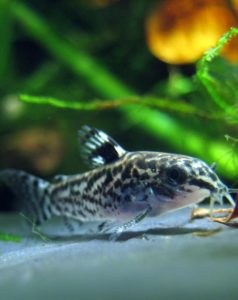 Corydoras Catfish are slow moving fish that feed from the bottom of the tank.
Corydoras Catfish are slow moving fish that feed from the bottom of the tank.
These can be paired with guppies perfectly. Because they are bottom feeders, take extra care they are eating enough, and to avoid sick fish in your tank.
This will prevent them from becoming aggressive due to hunger, a common occurrence.
Glass Fish
Beautiful, translucent creatures, a school of 5-6 glass fish is a great addition to your tank.
They are very hardy fish, and are sometimes stabbed with dye. Avoid those as they can become infected from their wounds from the dye needle.
Tiger Barbs
Tiger Barbs are best in a school to avoid picking on smaller fish. Corydoras Catfish are great tankmates for these feisty fellows.
Tiger Barbs can get along with a lot of different fish, but sometimes they will pick on smaller ones. Avoid smaller fish in your tank if you invest in a Tiger Barb. Tiger barbs can also do well in a school of them.
Mollies
Mollies, like betas, are beautiful fish, but it’s best to only have one male, or all females in your tank.
A male and female will stress each other out, so always have one male to every four females. Mollies are omnivorous, docile fish that get along with all kinds.
Tetras
Tetras get along with all fish, but it’s best to avoid putting fish that are much larger than them.
Swordtails
Swordtails are great with mollies and other fish of similar size.
Very peaceful, they genuinely enjoy the company of other fish.
What Types of Fish Should NOT be Kept Together?
Goldfish
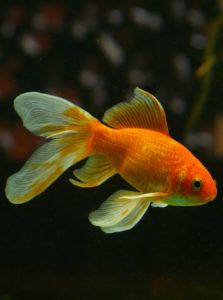 There’s a reason you always see goldfish alone. Goldfish need a lot of room, and are very territorial.
There’s a reason you always see goldfish alone. Goldfish need a lot of room, and are very territorial.
They do not like to share, and can grow to be quite large.
Cichlid
Cichlids are fairly aggressive, and only get along with each other. These are best in a tank all of their own.
Oscars are a kind of cichlids that have been known to be less aggressive to fish, but not of smaller size.
Angelfish are another kind of cichlid that can be incredibly docile, but must have a lot of room in their tank, and no small, active fish.
Bettas
Betta fish are beautiful additions to your tank, but you must pay special care to the sex.
You cannot have more than one male per tank. And that’s of any species. They will stress each other out, and fight to the point of death.
A male and female beta can be together for breeding purposes, but they must also eventually be separated because they are prone to fighting.
A group of female betas are beautiful, and can be with other fish.
Green Spotted Puffer
Guised as a friendly fish, these fish are actually best alone, or with other puffer fish.
If not they can be incredibly aggressive, causing a lot of stress and heartache.
How to Introduce Fish to Each Other
 There are a few things you can do to avoid stress on your new pet. One big investment that is worth it is a quarantine aquarium.
There are a few things you can do to avoid stress on your new pet. One big investment that is worth it is a quarantine aquarium.
This will help get your new fish acclimated to the water and nutrients, without immediately stressing out your other fish. Dimming the lights and feeding your other fish will help prevent aggression from either side.
Rearrange the decorations you have before adding your new pet. This will even the playing field and allow for all of the fish to develop new territories.
Little things will make a big difference in creating harmony in your aquarium.
Warning Signs Fish Are Not Getting Along
If you pay attention to the personalities of your fish, you can keep just about any fish together. Tropical fish fight over territory, mates and food.
Knowing things that can trigger your fish will prevent harm being done in the long run. Betas attack the color red, even if it is a different species sometimes.
Be sure to notice if your fish are hiding more often, or have ragged tails. This could be a sign of a fish being bullied. Sometimes a pecking order needs to be established which will cause restlessness in everyone.
If aggressive behaviors do not abate in a few days, it’s time to consider separating the bully fish, as long as the victim is not so bad that all the other fish are beginning to mess with them as well.
Don’t forget, fish like to play, so what can look like fighting can actually be them playing.
If there is no physical harm there is not much to worry about. But if there seems to be a constant stressor, consider ways to amend the issue before a fish gets hurt.
Final Thoughts
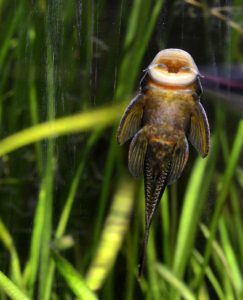 In the end the best thing to do is research the fish you have, and pay attention to their habits.
In the end the best thing to do is research the fish you have, and pay attention to their habits.
Showing a care in your tropical fish and their well-being will help you notice behavior changes quicker.
Sometimes simple fixes like adding a larger wall-like structure in the tank can help create ease in territory seeking fish.
A bigger tank can be a good help, or even having a group of fish of the same species to keep each other in check.
In the end, most fish can be kept together. Stick the tips listed above and you will have a harmonious fish tank for all to enjoy for the years to come.
